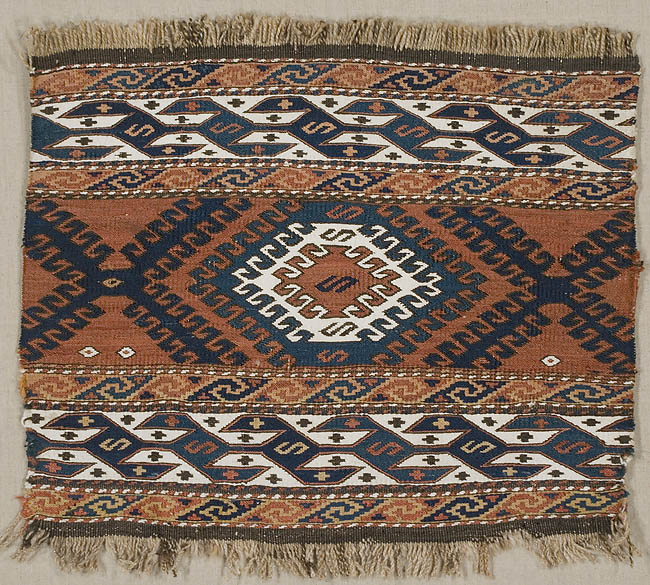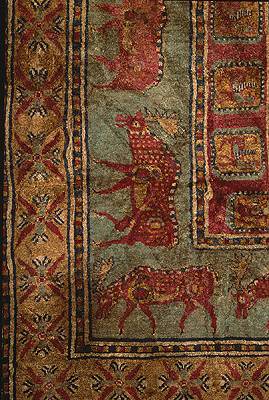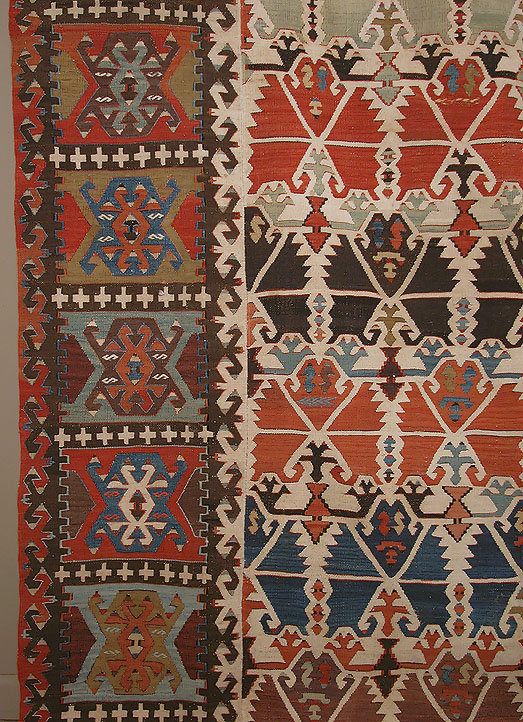|
Soumak
Soumak (also spelled soumakh, sumak, sumac, or soumac) is a tapestry technique of weaving sturdy, decorative fabrics used for carpets, rugs, domestic bags and bedding, with soumak fabrics used for bedding known as soumak mafrash. Soumak is a type of flat weave, somewhat resembling kilim, but with a stronger and thicker weave, a smooth front face and a ragged back, where kilim is smooth on both sides. Soumak lacks the slits characteristic of kilim, as it is usually woven with supplementary weft threads as continuous supports. The technique involves wrapping coloured weft threads over and under the warp threads, adding strength and embroidery-like pattern. Etymology The name 'soumak' may plausibly derive from the old town of in Azerbaijan, once a major trading centre in the Eastern Caucasus. Other theories include an etymology from Turkish , 'to skip up and down', meaning the process of weaving; or from any of about 35 species of flowering plant in the Anacardiaceae or sumac ... [...More Info...] [...Related Items...] OR: [Wikipedia] [Google] [Baidu] |
Oriental Rug
An oriental rug is a heavy textile made for a wide variety of utilitarian and symbolic purposes and produced in "Orient, Oriental countries" for home use, local sale, and export. Oriental carpets can be knotted-pile carpet, pile woven or Kilim, flat woven without pile, using various materials such as silk, wool, cotton, jute and animal hair. Examples range in size from pillows to large, room-sized carpets, and include carrier bags, floor coverings, decorations for animals, Islamic prayer rugs ('Jai'namaz'), Jewish Torah ark covers (''parochet''), and Christian altar covers. Since the High Middle Ages, oriental rugs have been an integral part of their cultures of origin, as well as of the European and, later on, the North American culture. Geographically, oriental rugs are made in an area referred to as the “Rug Belt”, which stretches from Morocco across North Africa, the Middle East, and into Central Asia and northern India. It includes countries such as Armenia, northern Chi ... [...More Info...] [...Related Items...] OR: [Wikipedia] [Google] [Baidu] |
Persia
Iran, officially the Islamic Republic of Iran (IRI) and also known as Persia, is a country in West Asia. It borders Iraq to the west, Turkey, Azerbaijan, and Armenia to the northwest, the Caspian Sea to the north, Turkmenistan to the northeast, Afghanistan to the east, Pakistan to the southeast, and the Gulf of Oman and the Persian Gulf to the south. With a Ethnicities in Iran, multi-ethnic population of over 92 million in an area of , Iran ranks 17th globally in both List of countries and dependencies by area, geographic size and List of countries and dependencies by population, population. It is the List of Asian countries by area, sixth-largest country entirely in Asia and one of the world's List of mountains in Iran, most mountainous countries. Officially an Islamic republic, Iran is divided into Regions of Iran, five regions with Provinces of Iran, 31 provinces. Tehran is the nation's Capital city, capital, List of cities in Iran by province, largest city and financial ... [...More Info...] [...Related Items...] OR: [Wikipedia] [Google] [Baidu] |
Kilim
A kilim ( ; ; ) is a flat tapestry-weaving, woven carpet or rug traditionally produced in countries of the former Persian Empire, including Iran and Turkey, but also in the Balkans and the Turkic countries. Kilims can be purely decorative or can function as prayer rugs. Modern kilims are popular floor coverings in Western households. Etymology The word 'kilim' originates from the Persian language, Persian () where it means 'to spread roughly', perhaps of Akkadian language, Akkadian or Aramaic, Aramean origin. History Like Pile weave, pile carpets, kilim have been produced since ancient times. The explorer Aurel Stein, Mark Aurel Stein found kilims dating to at least the fourth or fifth century CE in Hotan, China: :"As kilims are much less durable than rugs that have a pile to protect the warp and weft, it is not surprising that few of great age remain.... The Weaving, weave is almost identical with that of modern kilims, and has about fourteen threads of warp and sixt ... [...More Info...] [...Related Items...] OR: [Wikipedia] [Google] [Baidu] |
Shemakja
Shamakhi (, ) is a city in Azerbaijan and the administrative centre of the Shamakhi District. The city's estimated population was 31,704. It is famous for its traditional dancers, the Shamakhi Dancers, and also for perhaps giving its name to the Soumak rugs. Eleven major earthquakes have rocked Shamakhi but through multiple reconstructions, it maintained its role as the economic and administrative capital of Shirvan and one of the key towns on the Silk Road. The only building to have survived eight of the eleven earthquakes is the landmark Juma Mosque of Shamakhi, built in the 8th century. History Shamakhi was in antiquity part of successive Persian empires and was first mentioned as ''Kamachia'' by the ancient Greco-Roman Egyptian geographer Claudius Ptolemaeus in the 1st to 2nd century AD. Shamakhi was an important town during the Middle Ages and served as a capital of the Shirvanshah realm from the 8th to 15th centuries. Shamakhi maintained economic and cultural relation ... [...More Info...] [...Related Items...] OR: [Wikipedia] [Google] [Baidu] |
Saddle Bag
A saddle is a supportive structure for a rider of an animal, fastened to an animal's back by a girth. The most common type is equestrian. However, specialized saddles have been created for oxen, camels and other animals. It is not known precisely when riders first began to use some sort of padding or protection, but a blanket attached by some form of surcingle or girth was probably the first "saddle", followed later by more elaborate padded designs. The solid saddle tree was a later invention, and though early stirrup designs predated the invention of the solid tree, the paired stirrup, which attached to the tree, was the last element of the saddle to reach the basic form that is still used today. Present-day saddles come in a wide variety of styles, each designed for a specific equestrianism discipline, and require careful fit to both the rider and the horse. Proper saddle care can extend the useful life of a saddle, often for decades. The saddle was a crucial step in t ... [...More Info...] [...Related Items...] OR: [Wikipedia] [Google] [Baidu] |
Luristan
Lorestan province () is one of the Provinces of Iran, 31 provinces of Iran. Its capital is the city of Khorramabad. Lorestan is in the Western Iran, western part of the country in the Zagros Mountains and covers an area of 28,392 km2. In 2014 it was placed in Regions of Iran, Region 4. Lorestan is located close to the border with Iraq. Situated in a scenic valley surrounded by mountains, Lorestan lies approximately 100 kilometers (about 62 miles) east of the Iran–Iraq border, Iraqi border. Etymology The name ''Lorestan'' means "land of the Lurs." History The ancient history of Lorestan is closely intertwined with the rest of the Ancient Near East. In the 3rd and 4th millennium BC, migrant tribes settled down in the mountainous area of the Zagros Mountains. The Kassites, an ancient people who spoke neither an Indo-European languages, Indo-European nor a Semitic languages, Semitic language, originated in Lorestān. They would control Babylonia after the fall of t ... [...More Info...] [...Related Items...] OR: [Wikipedia] [Google] [Baidu] |
Caucasus
The Caucasus () or Caucasia (), is a region spanning Eastern Europe and Western Asia. It is situated between the Black Sea and the Caspian Sea, comprising parts of Southern Russia, Georgia, Armenia, and Azerbaijan. The Caucasus Mountains, including the Greater Caucasus range, have conventionally been considered as a natural barrier between Europe and Asia, bisecting the Eurasian landmass. Mount Elbrus, Europe's highest mountain, is situated in the Western Caucasus area of Russia. On the southern side, the Lesser Caucasus includes the Javakheti Plateau and the Armenian highlands. The Caucasus is divided into the North Caucasus and South Caucasus, although the Western Caucasus also exists as a distinct geographic space within the North Caucasus. The Greater Caucasus mountain range in the north is mostly shared by Russia and Georgia as well as the northernmost parts of Azerbaijan. The Lesser Caucasus mountain range in the south is mostly located on the territory of sout ... [...More Info...] [...Related Items...] OR: [Wikipedia] [Google] [Baidu] |
Shirvan
Shirvan (from ; ; Tat: ''Şirvan'') is a historical region in the eastern Caucasus, as known in both pre-Islamic Sasanian and Islamic times. Today, the region is an industrially and agriculturally developed part of the Republic of Azerbaijan that stretches between the western shores of the Caspian Sea and the Kura River, centered on the Shirvan Plain. History Etymology Vladimir Minorsky believes that names such as Sharvān (Shirwān), Lāyzān and Baylaqān are Iranian names from the Iranian languages of the coast of the Caspian Sea. There are several explanations about this name: * Shirvan or Sharvan are corrupted forms of the word "Shahrbān" () which means "the governor". The word "Shahrban" has been used since Achaemenian Dynasty as "Xshathrapawn" (satrap) to refer to different states of the kingdom. * Shervan in Persian means cypress tree (the same as 'sarv' in Middle Persian and in New Persian, as well as in ArabicDehkhoda dictionary). It is also used as a male n ... [...More Info...] [...Related Items...] OR: [Wikipedia] [Google] [Baidu] |
Shahsavan
Shahsavan (, also Romanized as Shāhsavan) is a village in Hojr Rural District, in the Central District of Sahneh County, Kermanshah Province, Iran Iran, officially the Islamic Republic of Iran (IRI) and also known as Persia, is a country in West Asia. It borders Iraq to the west, Turkey, Azerbaijan, and Armenia to the northwest, the Caspian Sea to the north, Turkmenistan to the nort .... At the 2006 census, its population was 252, in 63 families. References Populated places in Sahneh County {{Sahneh-geo-stub ... [...More Info...] [...Related Items...] OR: [Wikipedia] [Google] [Baidu] |
Anatolia
Anatolia (), also known as Asia Minor, is a peninsula in West Asia that makes up the majority of the land area of Turkey. It is the westernmost protrusion of Asia and is geographically bounded by the Mediterranean Sea to the south, the Aegean Sea to the west, the Turkish Straits to the northwest, and the Black Sea to the north. The eastern and southeastern limits have been expanded either to the entirety of Asiatic Turkey or to an imprecise line from the Black Sea to the Gulf of Alexandretta. Topographically, the Sea of Marmara connects the Black Sea with the Aegean Sea through the Bosporus and the Dardanelles, and separates Anatolia from Thrace in Southeast Europe. During the Neolithic, Anatolia was an early centre for the development of farming after it originated in the adjacent Fertile Crescent. Beginning around 9,000 years ago, there was a major migration of Anatolian Neolithic Farmers into Neolithic Europe, Europe, with their descendants coming to dominate the continent a ... [...More Info...] [...Related Items...] OR: [Wikipedia] [Google] [Baidu] |






